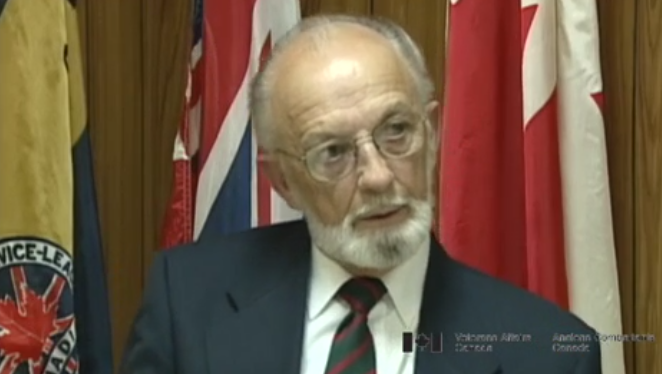I flew into a shell hole
First World War Audio Archive
I flew into a shell hole
Transcript
Picture of three soldiers posing together with arms behind their backs.
We used to patrol behind the lines, or for deserters, or maybe now and again some of the bloody Jerries broke through in some place or the other and that sort of thing. That’s where my real war experience began, because, on occasions when we’d be out on patrol, well, one thing happened. We were behind... and in those days in the trench warfare, they used to have behind the lines what was known as the observation balloons. We had them on our side too. Balloons, oh maybe seven or eight hundred thousand feet up in the air. And some poor devil up there in that balloon with field glasses scanning what was going on behind our lines, and their fellas were doing the same behind their lines. And, of course, when they see a patch, well maybe, a patrol consists mostly of six, six troopers and one sergeant or something like that. You see that, first thing you notice, sons of guns, they started bombing us with the confounded shrapnel. Now the shrapnel they had in those days, ‘16, weren’t as sophisticated as the later ones were, but they were bad enough and on one occasion, the damn shrapnel, this guy spotted us andPhoto of Veteran with blonde female child.
shrapnel landed in between the two of us. We used to be, oh, about that far apart, horses, and fortunately for me, one piece broke and hit my tin helmet and knocked me silly and the other piece, the other one exploded between - shattered the bowels of the horse and he bucked of course, and jeez I went through the bloody air and landed in this damn shell hole and I’d have been there yet if it hadn’t been, if it hadn’t been that... cavalry cloak in those days was something like a great big wide skirt Of course, it had to be when you (inaudible). If it hadn’t been that some poor other guy standing there and saw me and grabbed a hold of the back of my collar. He pulled me like this. I was unconscious and he stood me up against the (inaudible) and finally, finally Knox came along crawling on his tummy and he (inaudible) all the horses, killed them and then hauled me out and then the other chap out of the shell hole. Now that’s one of my memories, very clearly.Description
Mr. Vale describes being on cavalry patrol, being spotted by an observation balloon and being shelled with shrapnel bombs.
George Vale
George Vale was born in Montreal, Quebec on September 22, 1897. His father quit his job at the CPR and moved to Rougemont, Quebec and took up farming. Mr. Vale decided to leave the banking business and returned to school to study engineering. When the war started, he was too young to join the Queen’s Own Rifles, so he joined a volunteer force at Stoney Creek, Ontario. Once of age, he enlisted with the Canadian Mounted Rifles in January, 1916. He then sailed to England aboard the Lusitania in March, 1916, joined the Royal Canadian Dragoons, and by May of that year was in France. His primary role was as a Farrier, serving with the Canadian Railway Troops. After discharge, he worked in the property management office of the CPR in Toronto. In 1929, he joined the Crown Trust company rising to the position of comptroller in 1948. He retired in 1962. Mr. Vale married Winnifrid Reynolds of Aurora in 1920 and had two daughters. Mr. Vale died in the Veterans "K" Wing of Sunnybrook Hospital on February 15, 1984.
Meta Data
- Medium:
- Video
- Owner:
- Veterans Affairs Canada
- Duration:
- 2:38
- Person Interviewed:
- George Vale
- War, Conflict or Mission:
- First World War
- Location/Theatre:
- Europe
- Battle/Campaign:
- Somme
- Units/Ship:
- Canadian Mounted Rifles
- Occupation:
- Farrier
Attestation
Related Videos
- Date modified:



